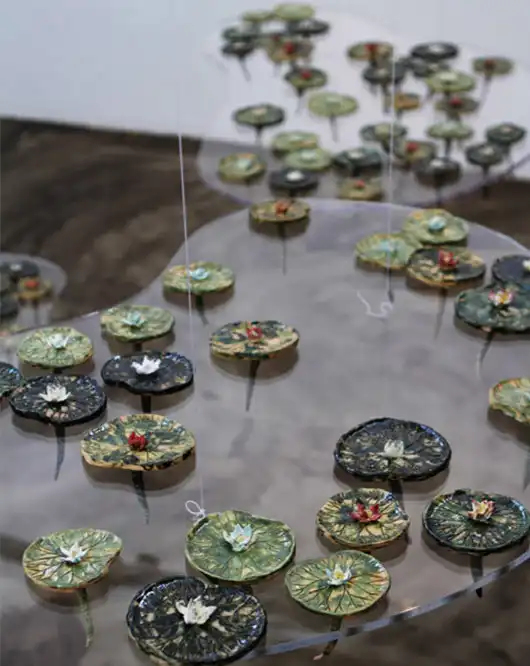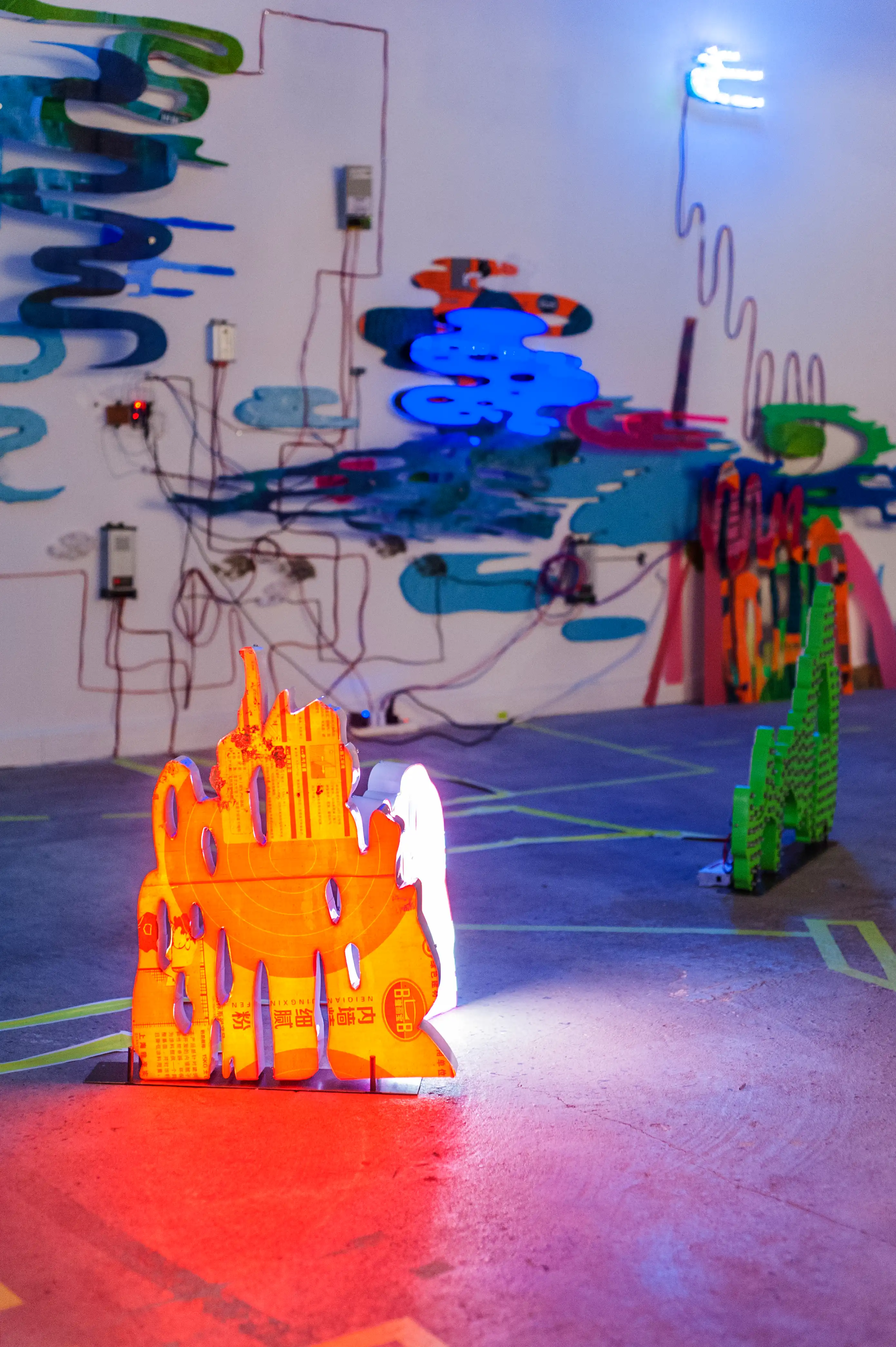Creative Activism: An Interview with NYUSH Professor Monika Lin
OCA Writer Olivia Bensimon sits down with NYU Shanghai Art Professor Monika Lin.
Since 2012, Lin has interviewed young women from the Chinese countryside who have come to Shanghai to work as manicurists, and painted their portraits on mirrors with nail polish. While exhibiting the first installation of her project “Lacquered” at a show in South Korea, Monika Lin paid close attention to the visitors’ interactions with the pieces. “From a distance, people were interested in them as objects and saw them as a portraits, but then as they moved closer, the focus started to shift,” she explained. “As one reached the object, there was an overwhelming impulse to view oneself and to use it as a mirror, and people were grooming and primping themselves,” she continued. Lin observed that once viewers got closer, the portrait became less about the young women and more about themselves, as they could see their reflection in the mirror more than the portrait of the manicurist. This unintended consequence became a kind of performance, Lin said, “that I imagined was occurring but that I had not seen myself to this extent.” At NYU Shanghai, she teaches students the basics of printmaking by encouraging students to explore themes of identity and place, themes she also engages with in her own works. On the day I visited her, Monika Lin looked the part of the artist. She wore her hair in a practical bun, a strand of light pink running through her dark locks. She was dressed in black, legs concealed by an artist’s apron with what seemed to be at least 20 pockets. She was soft spoken and casual, and diffused a Californian energy that quickly put me at ease. However, she does not describe herself as an “artist” so much as someone interested in the way the world works, the relationships that people have. She also happens to make and write things. Lin explained that she does not make “art for art’s sake,” but rather “art for knowledge’s sake.” Her creative process begins as a reaction to her curiosity. Whether it is from a story she heard or an article she read, the idea nags at her.

Her work takes different shapes, be it paintings, sculptures, or writing, but it is always multidimensional and interdisciplinary. One way of approaching Lin’s pieces is to see them first as objects, before understanding what they represent. She is an activist who uses a more visual medium to express her thoughts. Lin was born in New York and raised by a Chinese father and a Swiss mother, and grew up between New Jersey and California in the 1970s and 1980s. She moved to Shanghai in 2006 from Kansas City, Missouri, after taking a job as an art director at an American publishing company.Art became a part of Lin’s life when she was relatively young. “A kindergarten teacher encouraged my parents, and they took it upon themselves to provide extra classes as early as then,” she said. “It became such a part of my natural life that my story, my narrative, is less ‘How I became’ and just part of how I developed as a human being.”She remembers learning how to sew, knit, and crochet at her grandmother’s house in New Jersey when she was five years old. “I still use those skills, but in addition to that, they've informed my practice in a really deep way, and in my understanding of hierarchy within the art world and within the perceived hierarchy of skills,” Lin added. Since then, what she has wanted to create has influenced the way she thinks about the materials she uses, and the crafts, skills, or labor that she employs. “But at the root of it all, I have to say that my love of printmaking is still very much there and it's a thing that I return to,” Lin continued. “It seems, for me at least, to be a perfect combination of things that appeals to me physically, visually, and conceptually, as well as just a pure love of feeling that I've done good day’s work,” she said. Lin has been interested in combining her art with her conceptual and theoretical thoughts since she was in her 20s, but only felt the liberty to do so when she moved to Shanghai. “That was really freeing turn,” she said, “And it was the biggest turn in my career in terms of the kind work that I make and what I want to make.”

Furthermore, knowing that as a Westerner, her art would have a limited appeal to a Chinese audience, allowed her to develop her pieces into more politically provoking works than she may have been unable to make in another context. Her works engage in the larger discussions taking place in the contemporary art world, in particular ones that deal with the problem of representation. Like Kiki Smith, who uses her paintings and sculptures to address sex, birth, and rebirth, Lin, through the various media she uses, attempts, among other things, to raise awareness about underreported violence and crimes against women. She wants her work to stimulate people on multiple levels, so that they can understand what the object represents, in addition to its physical presence in the room. Her projects take between three and five years of thinking, researching, interviewing, and visualizing, before taking shape in her studio.For years, Lin has worked on two to five projects at a time in her studio. All of them interrelated and with a focus on how narratives shape the world, communities, and individuals. Lin explains “how important [narratives] are to our development as human beings, but also how manipulative and fraught with the ability to control and develop thought processes in a really violent way.” In 2010, she finished a project called “Shadow Count,” in Jingdezhen in China, a city known as a historical center of Chinese ceramics. “It was about the disparity between the number of rapes that are recorded officially in China, and the number of rapes that are recorded by NGOs,” Lin disclosed. According to Chinese government at the time, only 87 rapes per day were officially recorded throughout China, whereas NGOs reported at least ten times the number. The piece was 87 individual sculptures of flowers that were handcrafted out of porcelain and ceramic, that hung from the ceiling and that were lit by nine lights. “So the piece was actually the shadows making up the number of women that were not represented in the official records,” Lin concluded. Her works, despite taking their source in Chinese culture and history, address global issues like migration, labor, and rape. Lin wants her viewers to be provoked, she wants them to think about these more global issues in the same way she does. After 12 years in Shanghai, Lin said, “the way that I understand myself as an integrated cross-disciplinary person is much clearer,” than when she first arrived. “I actually feel that building a life here [with my family] has been a huge achievement because of the isolation, not knowing anyone, not speaking the language,” she continued. Despite the isolation, Lin finds comfort in the NYU Shanghai community. She said, “NYU has grown to the point where there is a really large population that comes from around the world and that is interested in examining the world around them.” Before then, the opportunity to discuss such central themes was more complicated “for those of us that can't converse on a high level in Mandarin.”
This article was written by Olivia Bensimon. Please send an email to managing@oncenturyavenue.com to get in touch. Photo Credit: Courtesy of Monika Lin